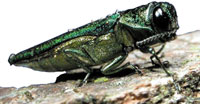Agrilus planipennis
Host
Ash species (except Mountain ash)

Photo credit: David Cappaert, Michigan State University.
Appearance and Life Cycle
The adult emerald ash borer is a metallic blue-green beetle. They are 8.5-14 millimetres (mm) long with an elongated body and a flat head. They emerge from trees in May or June and fly up to several kilometers to lay their eggs in bark crevices and cracks of ash trees from early June to late July. Approximately two weeks later, the eggs hatch into larvae which are creamy-white with brown heads. They reach a length of 26-32 mm at maturity and are flat and broad. The larvae chew into the cambium layer of the ash trees and create tunnels and galleries. The larvae overwinter inside the tree and pupate in the spring. The pupae are 10-14 mm long and creamy-white in colour. The pupae emerge as adults, completing the one year life cycle of the emerald ash borer.

Damage
Currently, the emerald ash borer has only been found in Eastern Canada. To see a distribution map, please visit the Canadian Food Inspection Agency's Emerald Ash Borer page. When ash trees are infested with the emerald ash borer, they show general symptoms of dieback and decline. These symptoms include diminished leaf density, thinning in the crown, bark loss and shoots growing from the trunk and branches. The adult emergence holes are 3-4 mm wide D-shaped holes that can be found on the bark of the tree. Adult emerald ash borers will feed on the leaves, forming irregular notches in them during the summer months. The damage done by the adults is minor compared to the damage done by the larvae. In the trunk and larger branches, the larvae form S-shaped tunnels in the sapwood of the tree and galleries which they fill with sawdust and frass. Vertical cracks in the bark can form above the galleries. The infested tree can die within 1 to 3 years.
Control
There are no chemical controls for the emerald ash borer. Woodpeckers allow a small degree of natural control. Infested trees should be removed and destroyed to prevent the spread of the insect. Restrictions have been placed against transporting any type of ash wood that might be infested without a Movement Certificate from the Canadian Food Inspection Agency. If you suspect that there is Emerald Ash Borer in your area, please contact the Canadian Food Inspection Agency.